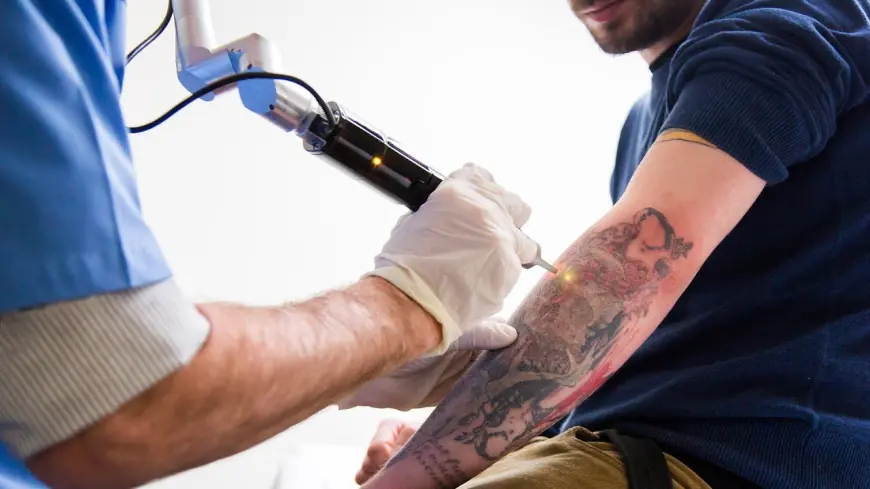Can Tattoo Removal Cause Scarring? How to Minimize Risks

Tattoo regret is more common than you might think, and with advancements in cosmetic treatments, removing unwanted ink has never been more accessible. Whether it’s a name from the past or a design that no longer fits your lifestyle, many people are now opting for Laser Tattoo Removal in Islamabad. This safe, effective treatment is available in reputable clinics like SKN Cosmetic Clinic and is gaining popularity for delivering great results with minimal downtime.
But one concern that lingers in many minds is: "Can tattoo removal cause scarring?" The short answer is — it can, but only under certain conditions. With the right preparation, skilled technicians, and proper aftercare, the risk of scarring is significantly reduced. Let’s break down the reasons why scarring might occur and how you can prevent it.
Understanding the Laser Tattoo Removal Process
Before we discuss risks, it's important to understand how laser tattoo removal works. The treatment involves using a high-intensity laser, such as a Q-switched or Pico laser, that penetrates the skin and breaks up ink particles. These tiny fragments are then naturally flushed out by the body's immune system over time.
This process targets only the pigment, leaving surrounding skin largely unaffected when done correctly. However, multiple sessions are usually required depending on the size, ink color, age, and depth of the tattoo.
What Causes Scarring After Tattoo Removal?
Scarring after tattoo removal is rare when performed by experienced professionals, but it can happen. Here are some of the primary causes:
1. Pre-Existing Scarring
If your original tattoo was done with heavy-handed techniques or poor ink quality, there may already be scarring under the surface. In this case, laser removal can’t remove that scar—it only clears the ink.
2. Improper Laser Technique
Using the wrong type of laser or incorrect intensity settings can burn or damage the skin. This usually happens when the provider is inexperienced or lacks proper training.
3. Infection
Failing to follow aftercare instructions may result in an infection, which increases your risk of permanent scarring.
4. Picking at Scabs
It can be tempting to touch or scratch the treated area as it heals, especially if blisters or scabs form. However, disturbing the healing skin can lead to scars.
5. Poor Aftercare
Sun exposure, harsh skin products, or skipping moisturization can also prolong healing and increase complications.
Signs of Scarring You Should Watch For
While temporary redness, swelling, and blistering are normal, you should be on alert if:
-
The skin remains discolored for months
-
Raised or bumpy tissue appears (hypertrophic or keloid scarring)
-
There's excessive pain long after the session
-
The texture of the skin changes permanently
How to Minimize the Risk of Scarring
The good news is, most people can complete laser tattoo removal without any scarring — if they follow the right steps.
1. Choose the Right Clinic
Your results largely depend on where you go for your treatment. Choose a clinic that has:
-
Certified dermatologists or laser specialists
-
FDA-approved Q-switched or Pico lasers
-
Proven experience in treating various skin tones and tattoo types
If you're considering Laser Tattoo Removal in Islamabad, ensure the clinic offers consultations and has a portfolio of past results. Don't hesitate to ask about success rates and potential side effects.
2. Stick to Your Treatment Schedule
Laser tattoo removal is a gradual process. Attempting to rush sessions or doing them too close together can over-stress the skin and increase the risk of complications. Your provider will usually recommend spacing sessions 6 to 8 weeks apart to allow your skin time to heal and ink to fade effectively.
3. Follow Aftercare Instructions Religiously
Post-treatment care is not optional—it’s critical. Some essential aftercare practices include:
-
Avoiding sun exposure: Always use SPF 50+ sunscreen on the treated area.
-
Keeping it clean: Gently wash the area and pat it dry.
-
Moisturizing: Use soothing, fragrance-free ointments like Aquaphor or aloe vera.
-
No picking or scratching: Let scabs or blisters heal naturally.
-
Wearing loose clothing: Tight garments can irritate the healing skin.
4. Avoid Smoking and Alcohol
Both smoking and excessive alcohol can impair your immune system, which slows healing and makes scarring more likely. For the best results, it's recommended to quit or reduce smoking during your treatment period.
5. Eat a Skin-Healthy Diet
A diet rich in Vitamin C, zinc, and antioxidants helps boost collagen production and supports the body’s natural repair process. Think: citrus fruits, green vegetables, and plenty of water.
6. Don’t DIY Tattoo Removal
Never try to remove a tattoo at home using creams, acids, or abrasive tools. These methods often result in chemical burns or infections, and in many cases, they cause worse scarring than the tattoo itself.
What to Do If You Suspect Scarring
If you notice signs of scarring:
-
Contact your provider immediately – They can assess the damage and suggest a treatment plan.
-
Apply topical treatments – Products with silicone, onion extract, or vitamin E may reduce scarring over time.
-
Consider laser resurfacing – If a scar is noticeable, some clinics offer fractional CO2 lasers to improve skin texture.
Final Thoughts
Tattoo removal is a life-changing process, offering emotional relief and a clean slate—but it’s not without its risks. Thankfully, scarring is uncommon, especially when handled by professionals and when the aftercare steps are carefully followed.
Your choice of clinic matters more than anything. For safe, effective, and professionally monitored Laser Tattoo Removal in Islamabad, turn to the trusted hands of SKN Cosmetic Clinic. With advanced technology, qualified specialists, and patient-centered care, SKN ensures that your skin is treated gently, safely, and with precision.
What's Your Reaction?
 Like
0
Like
0
 Dislike
0
Dislike
0
 Love
0
Love
0
 Funny
0
Funny
0
 Angry
0
Angry
0
 Sad
0
Sad
0
 Wow
0
Wow
0

















































